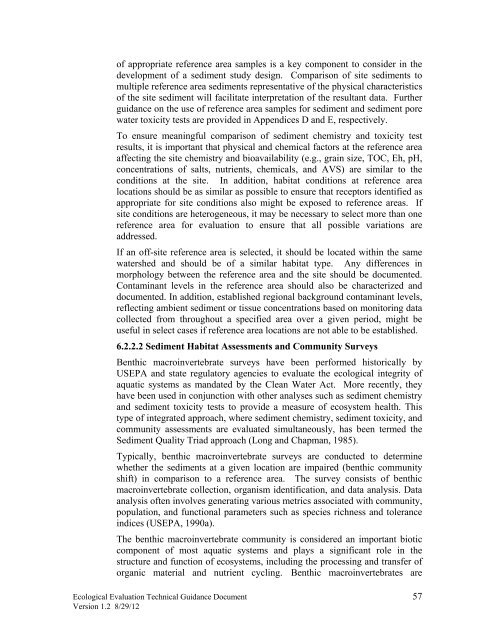Ecological Evaluation Technical Guidance - State of New Jersey
Ecological Evaluation Technical Guidance - State of New Jersey
Ecological Evaluation Technical Guidance - State of New Jersey
- No tags were found...
You also want an ePaper? Increase the reach of your titles
YUMPU automatically turns print PDFs into web optimized ePapers that Google loves.
<strong>of</strong> appropriate reference area samples is a key component to consider in thedevelopment <strong>of</strong> a sediment study design. Comparison <strong>of</strong> site sediments tomultiple reference area sediments representative <strong>of</strong> the physical characteristics<strong>of</strong> the site sediment will facilitate interpretation <strong>of</strong> the resultant data. Furtherguidance on the use <strong>of</strong> reference area samples for sediment and sediment porewater toxicity tests are provided in Appendices D and E, respectively.To ensure meaningful comparison <strong>of</strong> sediment chemistry and toxicity testresults, it is important that physical and chemical factors at the reference areaaffecting the site chemistry and bioavailability (e.g., grain size, TOC, Eh, pH,concentrations <strong>of</strong> salts, nutrients, chemicals, and AVS) are similar to theconditions at the site. In addition, habitat conditions at reference arealocations should be as similar as possible to ensure that receptors identified asappropriate for site conditions also might be exposed to reference areas. Ifsite conditions are heterogeneous, it may be necessary to select more than onereference area for evaluation to ensure that all possible variations areaddressed.If an <strong>of</strong>f-site reference area is selected, it should be located within the samewatershed and should be <strong>of</strong> a similar habitat type. Any differences inmorphology between the reference area and the site should be documented.Contaminant levels in the reference area should also be characterized anddocumented. In addition, established regional background contaminant levels,reflecting ambient sediment or tissue concentrations based on monitoring datacollected from throughout a specified area over a given period, might beuseful in select cases if reference area locations are not able to be established.6.2.2.2 Sediment Habitat Assessments and Community SurveysBenthic macroinvertebrate surveys have been performed historically byUSEPA and state regulatory agencies to evaluate the ecological integrity <strong>of</strong>aquatic systems as mandated by the Clean Water Act. More recently, theyhave been used in conjunction with other analyses such as sediment chemistryand sediment toxicity tests to provide a measure <strong>of</strong> ecosystem health. Thistype <strong>of</strong> integrated approach, where sediment chemistry, sediment toxicity, andcommunity assessments are evaluated simultaneously, has been termed theSediment Quality Triad approach (Long and Chapman, 1985).Typically, benthic macroinvertebrate surveys are conducted to determinewhether the sediments at a given location are impaired (benthic communityshift) in comparison to a reference area. The survey consists <strong>of</strong> benthicmacroinvertebrate collection, organism identification, and data analysis. Dataanalysis <strong>of</strong>ten involves generating various metrics associated with community,population, and functional parameters such as species richness and toleranceindices (USEPA, 1990a).The benthic macroinvertebrate community is considered an important bioticcomponent <strong>of</strong> most aquatic systems and plays a significant role in thestructure and function <strong>of</strong> ecosystems, including the processing and transfer <strong>of</strong>organic material and nutrient cycling. Benthic macroinvertebrates are<strong>Ecological</strong> <strong>Evaluation</strong> <strong>Technical</strong> <strong>Guidance</strong> Document 57Version 1.2 8/29/12
















